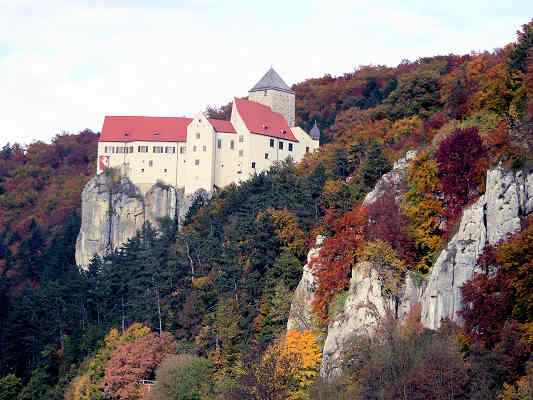
The Castle of Prunn
in Riedenburg / Prunn in the national park Altmuehl valley
In the Altmuehl Valley ![]() there are many castles, and quite a number of them exceed Prunn as to extent, value of equipment or age. Nevertheless, the comparatively small castle of Prunn is one of the best-known castles of Bavaria owing to its unique site and the harmonious combination of natural scenery and architectural performance.
there are many castles, and quite a number of them exceed Prunn as to extent, value of equipment or age. Nevertheless, the comparatively small castle of Prunn is one of the best-known castles of Bavaria owing to its unique site and the harmonious combination of natural scenery and architectural performance.
A document of A.D. 1037 mentions the name of the owner of the castle: Wernher of Prunn. One hundred years later the castle belonged to the family of the barons of Laaber and Breitenbrunn ![]() . At that time the oldest preserved parts of the castle were built, above all the mighty tower.
. At that time the oldest preserved parts of the castle were built, above all the mighty tower.
In 1338 the knights of Frauenberg bought the castle, and this family retained ownership until 1567. Their heraldic figure is the white horse which was painted on the outer wall of the castle. The most famous member of the family was Jack the Joyous, an experienced warrior whose marble gravestone is in the parish church of Prunn. An heirloom of his was an ornamented manuscript of the Nibelungenlied, the famous medieval German epic. It has been called the "Prunn Godex" and is now a unique specimen in the National Library of Bavaria.
In the 16th century the ducal councillor von Koekh remodelled parts of the castle. Two centuries later the Jesuits added rococo ornament to a number of rooms and to the chapel. Since 1822 the castle has been state property.
The White Horse of Prunn
Once upon a time there was a rich knight in Prunn who had no son. His heir apparent was his only daughter, a beautiful young lady. The old knight was apalled at the thought that all his riches should fall into the hands of a stranger by marriage. From many countries young knights flocked to the castle and asked for the young lady´s hand. But the old knight proclaimed an arduous condition. Only he should get permission to marry the lady who dared ride around the castle at the bottom of the wall. Some young men risked the dangerous ride on the steep slopes of the hill, but they all crashed down at the precipice where there is now the picture of the white horse.
One day a young and stately knight arrived as a wooer. From afar he caught a glimpse of the beautiful maiden, and in his heart of hearts he knew at once he´d rather lose his life than refrain from wooing. The young knight, however, had an old head on young shoulders, for he carefully studied the hazardous course around the castle - following the motto "look before you leap".
When he was near the precipice which had been fatal to his fellow wooers, he saw a piece of parchment dangling on a string, lie read: "The wall goes down to the bottom". When he looked up he saw the adored lady who gave him a shy smile and a wink. He bowed to the lady, and his heart beat passionately. Then he climbed down, tied to a rope, and he saw that the walls actually touched the bottom between a crevice, lie would fulfil the condition if he rode down at this spot.
The next day he appeared on his white horse. In front of the door he saluted the old knight with a bow and proclaimed his desire to win the lady´s hand. Then he rode around the castle both on the hillside and on the side of the precipice where he rode down to the bottom and crevice.
The old knight very reluctantly had to agree to the marriage when both his daughter and the young knight urged him to consent. They became a happy pair. To commemorate the risky ride the young knight had the picture of his white horse painted on the wall.
back to the Homepage of the town Riedenburg ![]()
Zuletzt aktualisiert am 10.02.2017